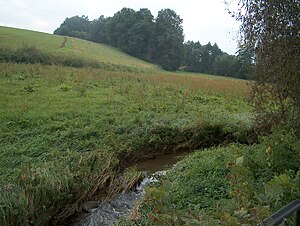Krabat or The Transformation of the World
Krabat or The Transformation of the World ( Upper Sorbian Krabat ) is the title of one of the most important novels by the Sorbian writer Jurij Brězan . It was published in 1976 in both German and Upper Sorbian .
background
Krabat is a legendary figure from Upper Lusatia , about whom countless legends and quarrels can be found, especially in the Sorbian folk poetry. In the most famous version of this legend, Krabat is a miller's apprentice who learns the art of magic from his master, but ultimately has to use it against him because the miller is in league with the devil.
The first more modern version of this legend, which became known beyond the borders of Lusatia, originated with the story Mišter Krabat (German title: Master Krabat the good Sorbian magician ) by Měrćin Nowak-Njechorński in 1954. This was translated into German by Jurij Brězan . In 1968 Brězan himself wrote a story based on the Krabat saga with the title The Black Mill (Sorbian: Čorny młyn ). In West Germany the figure Krabat especially by the 1971 Youth resulting book was Krabat of Otfried Preußler and based on this film by Marco Kreuzpaintner from the year 2008.
While the works mentioned are all about Fantastic Literature , Krabat or The Metamorphosis of the World was the first comprehensive work of the novel genre on the subject of Krabat. In 1993 another novel by Jurij Brězan was published with the title Krabat or The Preservation of the World , in Sorbian Krabat, druha kniha .
action
The main character of the novel is the Sorbian biologist Jan Serbin, who has already achieved world fame with his research in the field of genetics and received the Nobel Prize . He discovered a method that makes it possible to genetically modify people in such a way that they shed their negative traits such as greed and selfishness and even willingness to wage war. So hypothetically, it is now possible to create a better, peaceful world.
Serbin grew up in the Sorbian Upper Lusatia and has therefore been familiar with the Krabat myth since childhood. In order to realize his dream of improving the world in the aforementioned method, i.e. to transform it , he tries to become Krabat himself. In this way the legend becomes reality and in the course of the plot the real and the fantastic mix, and space and time boundaries are also eliminated. Throughout the novel there is a constant change of levels of action in space, time and degree of reality. So the story takes place at the same time in Jan Serbin's parents' house in Upper Lusatia, in distant countries like Sweden or Italy, where Serbin is on a scientific mission, as well as in a fantasy world in which Krabat and his companion Jakub Kuschk roam the country against that fights evil embodied by Count Wolf Reissenberg and is in search of the land of happiness and his lost love, the girl Smjala. Only towards the end of the work do all of these storylines come together.
It is therefore a fantastic novel that is also critical of science and society and also deals with philosophical questions, including the question of the extent to which the end justifies the means.
Remarkable
A recurring topos throughout the entire plot is a brook called Satkula . This brook actually exists in Upper Lusatia. In the novel, for example, it appears as a place where Krabat experiences his adventures, as well as a brook near the hill on which Jan Serbin's parents' house is located. A reference to Brězan's hometown Dreihäuser / Horni Hajnk can be seen here .
The Satkula stands here on the one hand as a symbol for the world and life on a small scale, accessible to ordinary people, and on the other hand as a metaphor for the homeland and the people of the Sorbs. The terms Sorbe or Sorbian do not appear in the entire novel, nor are any other real locations or other geographical names in Upper Lusatia mentioned, with the exception of the Satkula.
meaning
First published in 1976, the book is one of the first important literary discussions about the risks of biology and genetic engineering. On top of that, this book can be described as one of the greatest literary works ever written in the Sorbian language.
Book editions
Jurij Brězan: Krabat or The Transformation of the World . Suhrkamp, Frankfurt am Main 2004, ISBN 978-3-518-45591-3
